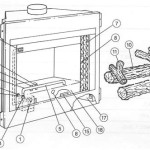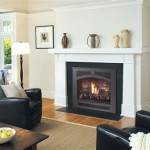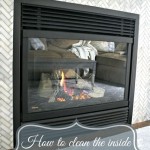Fireplace Mortar Repair: A Home Depot Guide
Fireplace mortar, the binding agent between bricks or stones in a fireplace, is crucial for its structural integrity and safe operation. Over time, exposure to high temperatures, moisture, and the elements can cause this mortar to crack, crumble, or deteriorate. Addressing these issues promptly is vital to prevent further damage and maintain the fireplace's efficiency and safety. Home Depot provides a range of products and resources for homeowners seeking to undertake fireplace mortar repair.
This article outlines the process of fireplace mortar repair, focusing on the types of mortar available at Home Depot, the necessary tools, and the essential steps for a successful DIY project. While this guide offers helpful information, consulting with a qualified professional is always recommended, especially for complex or extensive repairs.
Assessing the Damage and Choosing the Right Mortar
Before beginning any repair work, thoroughly inspect the fireplace mortar for signs of damage. Look for cracks, crumbling, missing mortar, or areas where the mortar has completely deteriorated. The extent and location of the damage will influence the type of mortar required and the scope of the repair. Hairline cracks might be addressed with a simple patching compound, while larger gaps and missing mortar will require a more substantial mortar mix.
Home Depot stocks various types of mortar suitable for fireplace repair. The correct choice depends largely on the original mortar used in the fireplace construction. Using the wrong type of mortar can lead to further damage due to differing expansion and contraction rates. Common types of mortar available include:
- Type N Mortar: A general-purpose mortar suitable for both interior and exterior applications. It offers a good balance of strength and flexibility.
- Type S Mortar: A high-strength mortar designed for applications requiring greater load-bearing capacity. It is generally used for foundations and load-bearing walls but can be appropriate for some fireplace applications, particularly in areas subject to significant stress.
- Refractory Mortar: Also known as fire clay mortar, this is specifically designed for high-temperature environments. It is formulated to withstand the extreme heat generated within a fireplace firebox. This mortar is crucial for repairing areas directly exposed to flames.
- Pre-Mixed Mortar: Convenient for smaller repairs, pre-mixed mortars are available in tubs and do not require mixing with water. These are typically suitable for patching and filling small cracks.
When selecting a mortar, carefully read the product descriptions and specifications to ensure it is compatible with the existing mortar and suitable for the intended application within your fireplace. If uncertain, consult with a Home Depot associate or a masonry professional for guidance.
Gathering the Necessary Tools and Materials
Successful fireplace mortar repair requires the right tools and materials. In addition to the selected mortar, the following items are generally necessary:
- Mortar Removal Tools: A cold chisel and a brick hammer are essential for removing old, damaged mortar. A power tool with a mortar-removing attachment can expedite the process, especially for larger areas.
- Trowel: A pointing trowel is specifically designed for applying mortar in tight spaces and creating smooth, professional-looking joints.
- Margin Trowel: Used for mixing small batches of mortar and transferring it to the pointing trowel.
- Hawk: A flat square tool used to hold mortar while working.
- Mixing Container: A bucket or tub for mixing the mortar with water.
- Water: Clean water is necessary for mixing the mortar to the correct consistency.
- Grouting Sponge: Used for cleaning excess mortar from the bricks or stones and creating a smooth finish.
- Dust Brush: For cleaning debris and dust from the work area before applying new mortar.
- Safety Glasses: Essential for protecting eyes from flying debris during mortar removal.
- Gloves: Protect hands from abrasion and contact with mortar.
- Dust Mask: To prevent inhalation of dust particles during mortar removal and mixing.
Home Depot carries all of these tools and materials, often offering kits that bundle essential items for mortar repair. It is advisable to gather all necessary supplies before commencing the project to ensure a smooth and efficient workflow.
The Step-by-Step Repair Process
Following a systematic approach is crucial for effective fireplace mortar repair. The process generally involves preparing the area, removing the old mortar, mixing the new mortar, applying the new mortar, and finishing the joints.
- Preparation: Begin by cleaning the work area, removing any loose debris, dust, or dirt. Use a dust brush or vacuum cleaner to ensure a clean surface for the new mortar. Protect the surrounding area with drop cloths to prevent splatters.
- Mortar Removal: Carefully remove the deteriorated mortar using a cold chisel and brick hammer. Angle the chisel to avoid damaging the surrounding bricks or stones. For larger areas, consider using a power tool with a mortar-removing attachment. Remove the mortar to a depth of approximately twice the width of the joint.
- Mixing the Mortar: Follow the manufacturer's instructions for mixing the mortar with water. Add water gradually while mixing thoroughly until the mortar reaches a workable consistency, similar to that of thick peanut butter. Avoid adding too much water, as this can weaken the mortar.
- Applying the Mortar: Use a pointing trowel to carefully apply the mortar to the cleaned-out joints. Pack the mortar firmly into the joints, ensuring it fills the entire space. Overfill the joints slightly to allow for shrinkage during the curing process.
- Finishing the Joints: Once the mortar has partially set (typically after about an hour, depending on temperature and humidity), use a grouting sponge to clean excess mortar from the bricks or stones. Smooth the joints with the pointing trowel to create a consistent and professional finish. Various joint styles can be achieved, such as flush, concave, or V-shaped.
- Curing: Allow the mortar to cure according to the manufacturer's instructions. This typically involves keeping the area slightly damp for several days. Cover the repaired area with plastic sheeting to prevent the mortar from drying out too quickly.
Proper curing is essential for the mortar to achieve its full strength and durability. Avoid using the fireplace for several days after the repair to allow the mortar to fully cure.
Fireplace mortar repair is a manageable DIY project for many homeowners. Thorough preparation, careful execution, and the use of appropriate materials from retailers such as Home Depot contribute to a successful and long-lasting repair. However, it is important to reiterate that professional assistance should be sought where the damage is extensive, or when the homeowner feels uncertain about undertaking the work.

Dap 10 1 Oz Gray Concrete And Mortar Filler Latex Sealant 18096 The Home Depot

Rutland 10 3 Fl Oz Fireplace Mortar Black Cartridge 63 The Home Depot

Quikrete 10 Oz Fireplace Repair Mortar 862024 The Home Depot

Quikrete 20 Lb Fast Set Repair Mortar Mix 124120 The Home Depot

Quikrete 10 Oz Mortar Repair Sealant 862009 The Home Depot

Rutland 12 1 2 Lbs Castable Refractory Cement Tub 600 The Home Depot

Quikrete 10 Oz Mortar Repair Sealant 862009 The Home Depot

Dap 10 1 Oz Black High Heat Mortar Sealant 12 Pack 7079818854 The Home Depot

Rutland 10 3 Oz Fireplace Mortar Buff Cartridge 63b The Home Depot

Imperial Castable Refractory Cement 3 Lb Kk0061 Réno Dépôt
Related Posts








